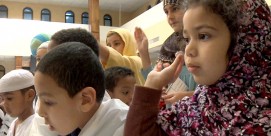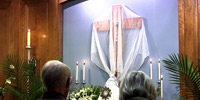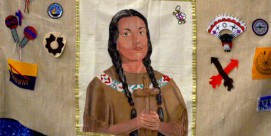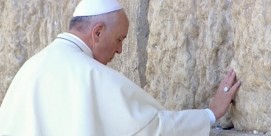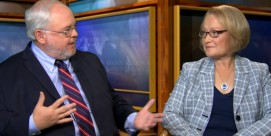In This Episode << SLIDE LEFT TO SEE ADDITIONAL SEGMENTS
Taizé
BOB ABERNETHY: This month in eastern France, the Christian ecumenical community in Taizé is celebrating its birthday. It was founded at the beginning of World War II by a young Swiss theologian named Roger Shutz who wanted to work for peace and help refugees by celebrating Christian unity. Today, more than 100 men — Catholic, Protestant, and Eastern Orthodox, from all over the world — are monks there, led by Brother Roger. The community has no preaching but has become famous for its simple, meditative music, and prayer. Many thousands of visitors, especially young people, travel to Taizé every summer, and this past summer Paul Miller did, too. We begin with his report.
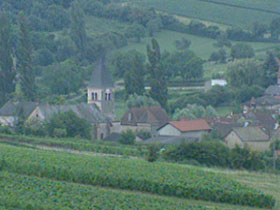
PAUL MILLER: At 8:30 each morning, in the small town of Taizé, the bells call people to the first of three daily services. On this day, 6,000 people will answer the call.
Brother EMILE (Taizé Brother): People want to be touched — not just in an emotional, sentimental sense, but what the Bible means by heart is something much deeper, the real me that wants to be touched by God. That’s what draws people.
MILLER: Taizé was founded by Brother Roger, the son of a Swiss Calvinist pastor. He too is Protestant, but in 1940, he was drawn to this part of Burgundy by the famous medieval Catholic monastery of Cluny, five miles from Taizé.
The town was also near the border between German-occupied northern France and the Vichy-controlled South. It quickly became a place of refuge — Brother Roger offered shelter to Jews and others fleeing the Nazis until he was warned they had been betrayed. Everyone escaped safely.
After the war, he returned to Taizé to found a community of Christian brothers, committed to celibacy, simplicity, and spiritual sharing. Catholic, Orthodox, and Protestant, now from 25 countries, they hold common Christian beliefs and conduct services with no liturgy and no priest leading them. Brother Roger, now 87, says his community is dedicated to listening — to God, and to others.
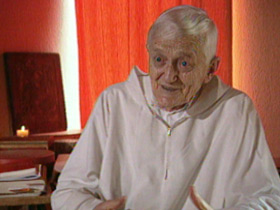
Brother ROGER (in translation): Searching together — not wanting to become spiritual masters who impose — God never imposes. We want to love and listen, we want simplicity.
MILLER: Young people began coming here on their own in the late 1950s, looking for communion with God and with people from other countries.
AMY GATJE (Los Angeles, California): For me, being at Taizé is a living experience of the kingdom of God — you have people from all over the world speaking every language imaginable. They are together to worship God, to seek peace, to listen to one another.
CALEB NELSON-AMAKER (Charlottesville, Virginia): When you come to Taizé you’re put in a group with a bunch of people from different cultures, different societies, and there’s nothing planned about it — there are no planned answers, it’s all reality.
MILLER: The most important part of the experience is the services, and young people have responded to Taizé in ever increasing numbers, asking to participate in the worship. Now thousands are invited each summer. But the emphasis is less on being here and more on what happens when they go home.
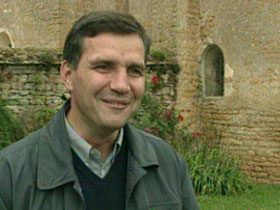
They are asked to be part of a pilgrimage of trust — to be involved in their own communities, to be peace makers and witnesses for reconciliation.
Brother EMILE: We like the word “pilgrim” because a pilgrim is someone who doesn’t have all the answers, who is poor; someone who doesn’t carry all the answers in his luggage but someone who sets out because of his or her faith. And that’s what we wanted to propose to people — to take a risk because of your faith.
MILLER: The number of pilgrims has grown — and so has the popularity of the Taizé service. For RELIGION & ETHICS NEWSWEEKLY, I’m Paul Miller in Taizé, France.
BOB ABERNETHY: The spirituality of Taizé services has influenced Christian worship around the world, including in the U.S. Every month at Ascension Catholic Church in Oak Park, Illinois, there is a special Taizé service. David Anderson is the music director there.
DAVID ANDERSON (Music Director, Ascension Catholic Church, Oak Park, Illinois): Many people that come to this service probably do have a church they go to on Sundays. But this is a different way for people to experience the holy, to try to open themselves to God’s presence in their life.

The service begins with several Taizé chants.
The purpose of those two or three chants that we begin with is to help people make the transition from the business of their day into the spirit of the prayer.
At our monthly prayer we have a candle lighting. All the children will come forward to the cross and light their candles, and they’ll take their candles through the church. And at that time everybody stands and we sing an alleluia.
The purpose of the service of light is to remind people that Christ is the light that shatters all darkness in the world. It’s a very joyful time in the service.
There is normally a Scripture reading. The point of the Scripture is to proclaim God’s word, to allow people to hear God’s word. Later in the service it will provide a source for people to meditate on.
There’s no preaching at a Taizé service. We listen to God’s word and we offer our prayers. We don’t have some dogmatic sermon or homily; it’s pure prayer in that way.
Then, people will bring their candles forward — a great procession of light. They will place their candles in containers around the altar area.
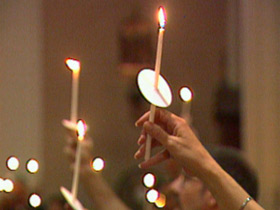
There are various icons, ancient Christian images.
For some people it’s a wonderful way of being united with everyone that’s here. It seems that Christians often want to focus on their differences instead of the unity that already exists.
In the United States we often talk about building Christian unity. But in the mind of the Taizé community, it’s helping people come to an awareness of the unity we already share.
That lighted candle can be symbolic of a prayer they’re holding in their heart. It can be symbolic of a loved one or a friend who’s in great need.
We have a period of silence. And the period of silence lasts about ten minutes.
Everybody in this church prays in a different way. What we try to provide here is a place and a space for people to encounter the presence of God in silence.
Then we have intercessory prayer, and we believe that’s one of the greatest things we can do — pray for each other and pray for peace. We open it up in the church, and we allow people to pray for whatever the feel they need to pray for.
We end with a final hymn or song or chant. Music can be very powerful. It doesn’t have to be extravagant, it can be very simple. And that is the whole point of worship music. It’s supposed to help people in their spiritual search.

